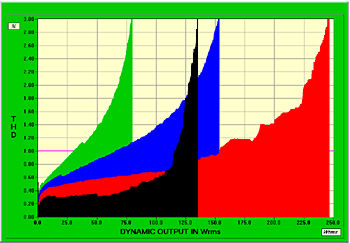| Columns Retired Columns & Blogs |
Sharp SM-SX100 digital integrated amplifier Measurements part 3
Because its output stage is switching between the full ±32V voltage rails all the time, even when there isn't an output signal present, the Sharp doesn't clip like a conventional amplifier. Looking at the output waveform on a 'scope while I drove it into overload—don't try this at home, gentle readers—revealed the sinewave to become triangular in shape, with bursts of ultrasonic noise increasingly becoming apparent on the positive and negative peaks.
I investigated the Sharp's peak power delivery with the Miller Audio Research Amplifier Profiler, a "virtual instrument" (realized on a National Instruments DSP PC card) that drives the amplifier under test with a low-duty-cycle 1kHz toneburst (10 cycles on, 400 cycles off). The results for the 8 ohm output setting are shown in fig.8, and illustrate the importance of matching this amplifier to the speaker load.

Fig.8 Sharp SM-SX100, 8 ohm output, distortion (%) vs 1kHz burst output power into 8 ohms (black trace), 4 ohms (red), 2 ohms (blue), and 1 ohm (green).
The Sharp more than meets its specification under these conditions, with 116.4W available into 8 ohms at the standard 1% THD+noise level (black trace). This increases to 155W into 4 ohms, with a whopping 242W available at a relaxed 3% THD+N (red trace). But this extra power is obtained at the cost of a big increase in distortion. And into 2 ohms (blue) and 1 ohms (green), just 65.5W and 30.7W are available, with even higher levels of distortion apparent. With the 4 ohm setting, 58.5W and 89.6W were available into 8 and 4 ohms, respectively, for 1% THD+N. Maximum output current appeared to be limited to around 5.5A into any load for the same 1% THD+N.
As I said earlier, the Sharp SM-SX100 is not really an amplifier, but a D/A converter with a high-power output stage. It therefore made sense to examine its performance in the digital domain. Other than the jitter test, for the following measurements the amplifier was driven with a TosLink connection and its volume control set to "71" to give an output of 20V RMS into 8 ohms in order to maximize measurement dynamic range.
The SM-SX100's linearity error plotted against absolute level is shown in fig.9. This error is very low down to -90dBFS, but then increasingly becomes positive due to the presence of noise.

Fig.9 Sharp SM-SX100, departure from linearity, 16-bit data (2dB/vertical div., right channel dashed).
Fig.10 shows a 1/3-octave spectral analysis of the amplifier's output while it decoded data representing a dithered tone at -90dBFS. The 1kHz tone kisses the -90dB line, confirming the excellent linearity, but there are spectral components also present at 550Hz and 2kHz. The latter may well be a spurious tone from the Audio Precision System One, but the former might be an idle tone of some kind, the bane of aggressive noiseshaping topologies. Note also the rise in the noise floor in the top two audio octaves, the beginning of the noiseshaping curve, and the overall high level of the noise floor—significantly higher than with the best 16-bit D/A sections. (See the measurements accompanying Jonathan Scull's review of the Accuphase DP-75V CD player, elsewhere in this issue.)

Fig.10 Sharp SM-SX100, 1/3-octave spectrum of dithered 1kHz tone at -90dBFS, with noise and spuriae, 16-bit data (right channel dashed).
- Log in or register to post comments




































